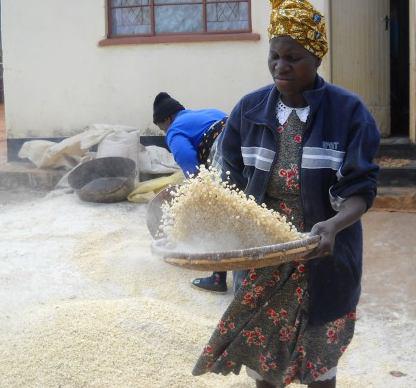| States of Matter |
|---|
| Air |
| Liquids |
| Magnetic and non-magnetic |
| Separating mixtures |
| Assessment |
Materials generally mix when two or more of them are put together.
They combine to form a mixture.
A mixture can be between:
There are several methods of separating mixtures. The common ones are:
The wind is used to separate wharves (chaff), small sticks, and dry leaves, from grains or seeds by blowing the chaff away.
Chaff is usually lighter than the grains.

a sieve is used to separate mixtures of particles of different sizes. For example stones from flour.
The larger particles remain on the sieve while the finer ones pass through.
Here the large particles are separated from smaller ones by observing them and using the hands to remove the unwanted ones.
For example, stones are separated from rice or beans in this way.
This method is used to separate a liquid from particles that cannot dissolve in it.
For example, separating sand from water using filter paper or piece of cloth.
This is when a liquid is separated from large particles of solids by pouring the liquid out gently.
For example, pouring off kerosene that has mixed with tiny ball bearings.
a magnet is used to separate magnetic materials that may have mixed up with powder or other nonmagnetic materials.
For example, a magnet is used to separate iron filings from sugar.
a solid that has dissolved in a liquid is separated in this way. The liquid is heated until it evaporates and the solid is left behind.
For example, salt dissolved in water can be recovered by evaporation.
1. Which one of the following mixtures is wrongly matched with the method of separating the two substances in their mixture?
|
Mixture |
Method of separation |
| A. Sand and water |
Filtering |
| B. Iron and copper |
Using a magnet |
| C. Coarse sand and fine clay particles |
Sieving |
| D. Salt and water |
Decanting |
2. Decanting can be used to separate
A. A solid that dissolves in a liquid
B. An insoluble in a liquid
C. Two liquids that can mix
D. Two solids that can mix
3. Which one of the following mixtures can be separated by decanting?
A. Sand and water B. Sand and sugar
C. Salt and water D. Salt and iron filings
4. Which one of the following mixtures can be separated by dissolving, filtering and evaporating?
A. Charcoal powder and iron filings
B. Common salt and sand
C. Common salt and sugar
D. Maize flour and iron filings
5. Which one of the following mixtures CANNOT be separated by either dissolving, filtering and evaporating or by using a magnet?
A. Iron fillings and maize flour B. Salt and sugar
C. Salt and sand D. Iron filings and sand
6. Which one of the following is the most convenient first step in separating a mixture of salt, iron filings, sand, and sawdust?
A. Using a magnet to remove iron filings
B. Using a sieve to remove sand and sawdust
C. Adding water to dissolve the salt
D. Burning to get rid of sawdust